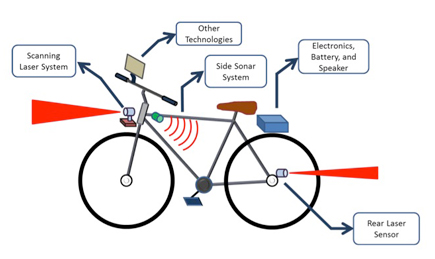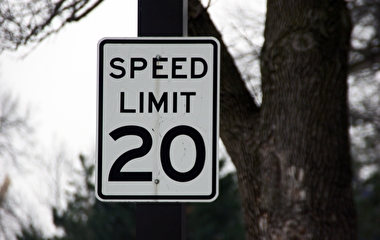More than 48,000 bicycle–motorist crashes happen each year in the United States. Many of these crashes occur because either the driver does not see the bicyclist or the bicyclist behaves in an unpredictable manner.
In recent years, manufacturers have begun equipping many new motor vehicles with collision-prediction systems that warn motorists of possible collisions and help them take actions to avoid a crash. Now, researchers at the Roadway Safety Institute are investigating the use of similar technology on bicycles to predict impending crashes and warn both riders and drivers.
“In this project, we are working to develop a sensor system for a bicycle that can predict imminent bicycle–motorist crashes and provide an audio warning of the bicycle’s presence to nearby drivers by sounding a loud horn,” says Rajesh Rajamani, professor of mechanical engineering at the University of Minnesota and the lead investigator on the project.
The warning system focuses on predicting two of the most common types of bicycle–motorist crashes: rear-end collisions on urban roads in which the vehicle is approaching the bicyclist from behind and collisions at traffic intersections.
Rajamani and doctoral student Woongsun Jeon are currently developing a sensor system and collision-prediction algorithm and testing the algorithm in simulation studies. The researchers have also built an instrumented bicycle with sensors, electronics, and a small computer for evaluation.
“This project is unique in many ways,” Rajamani says. “Previous projects on vehicle tracking have been developed only for cars and have mostly focused on highway scenarios. This is perhaps the first research project where tracking of vehicles at a traffic intersection has been developed and also the first project for a bicycle collision-warning system that goes beyond rear or straight-frontal collisions.”
Just nine months into the project, researchers have taken a Schwinn bicycle equipped with the new warning system out for tests on the U of M campus—and seen promising results. Preliminary experiments have shown that the sensor suite on the bicycle can accurately estimate vehicle position and orientation for scenarios involving vehicles approaching cyclists from behind and vehicles turning right at intersections.
“If our final results demonstrate that the system works reliably and performs effectively, it could be commercialized into an inexpensive product sold to bicycle riders,” Rajamani says. “In addition, the technology we’re developing has the potential to be extended to motorcycles and pedestrians in the future.”





